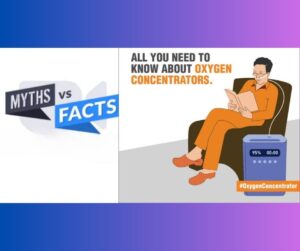“10 Myths About Oxygen Concentrators: What You Need to Know”
July 25, 2024 2024-07-30 11:32“10 Myths About Oxygen Concentrators: What You Need to Know”
“10 Myths About Oxygen Concentrators: What You Need to Know”
Fact: Oxygen concentrators are used by a range of people, from those with chronic obstructive pulmonary disease (COPD) to those needing supplemental oxygen during exercise or sleep.
Myth: Oxygen concentrators produce pure oxygen.
Fact: Oxygen concentrators filter and concentrate oxygen from the air, typically delivering oxygen concentrations between 87% to 95%. They do not produce 100% pure oxygen like medical-grade oxygen tanks.
Myth: Oxygen concentrators are noisy.
Fact: Modern oxygen concentrators are designed to be quiet, especially during operation in home settings. Noise levels are typically comparable to background household appliances.
Myth: Oxygen concentrators are complicated to use.
Fact: Most oxygen concentrators are straightforward to operate with simple controls. Manufacturers provide user manuals and support to ensure proper usage.
Myth: Oxygen concentrators are expensive.
Fact: While initial costs can be significant, oxygen concentrators are often more cost-effective over time compared to regular refills of oxygen cylinders.
Myth: Oxygen concentrators are hazardous because they deliver oxygen under pressure.
Fact: Oxygen concentrators deliver oxygen at low flow rates and pressures, which are safe for most users when used correctly. They do not pose the same risks as compressed oxygen cylinders.
Myth: Using an oxygen concentrator means I am dependent on it forever.
Fact: Many people use oxygen concentrators temporarily or intermittently, such as during recovery from surgery or managing a chronic condition. It’s a tool to support oxygen needs as prescribed by healthcare providers.
Myth: Oxygen concentrators are bulky and difficult to move.
Fact: While older models may have been bulky, newer models are more compact and lightweight, designed for easier mobility within the home and even for travel.
Myth: Oxygen concentrators require special maintenance.
Fact: Routine maintenance, such as cleaning filters and checking tubing, is typically straightforward and outlined in the user manual. Most concentrators are designed for minimal maintenance.
Myth: Oxygen concentrators can treat COVID-19.
Fact: While oxygen concentrators can provide supplemental oxygen, they do not treat COVID-19 itself. They are used to manage symptoms like low blood oxygen levels in COVID-19 patients under medical supervision.
CONCLUSION
Understanding the truth behind these myths about oxygen concentrator helps to reduce unnecessary fear and stigma associated with using oxygen concentrators. It’s crucial to consult healthcare professionals for personalized advice and to rely on credible sources for information. By dispelling these myths about oxygen concentrators, we can improve the quality of life for those who need supplemental oxygen and ensure they receive the best possible care.
This knowledge empowers patients and caregivers, enabling them to make well-informed decisions. Ultimately, spreading accurate information fosters a more supportive and understanding community for those relying on oxygen therapy.
Additionally, it encourages the development of better technologies and services tailored to the needs of oxygen concentrator users. Informed patients are more likely to adhere to their treatment plans, leading to improved health outcomes and a greater sense of well-being.




